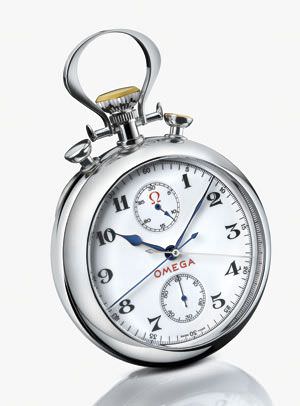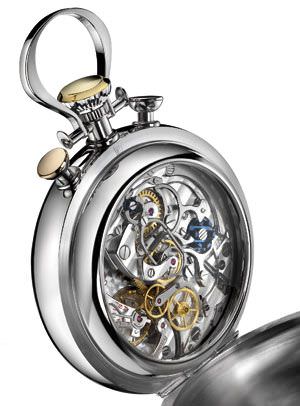
As the Official Timekeeper for eleven Olympic Winter Games, Omega has seen some extraordinary feats during the years – such as Diana Gordon-Lennox finishing last in the Alpine Combined event and receiving a standing ovation because she had completed the last two runs with a broken arm and only one pole.
There are many others and to commemorate them, Omega has created an advertising campaign using a series of posters entitled ‘Great Moments in Time’ that evoke the look and feel of its years as Official Timekeeper. The posters seen here, were presented for the first time in November 2005 at the Olympic Museum in Lausanne, Switzerland.


The Omega Pocket Watch 1932
The same day, Omega introduced its 1932 Pocket Watch. The project began when the company discovered a number of unassembled chronograph movement kits which were in fact the very components in the Omega chronographs used at the 1932 Olympic Games. The decision was made to produce an enhanced replica using as many of the original recondit-ioned parts as possible, with some new parts being made as well as the creation of new tools. Using the original movement design drawings that were eventually found on microfilm, the project and the challenge was launched.
The heart of the movement in the Omega Calibre 3889A with an integrated rattrapante chronograph mechanism is controlled by a double column wheel. The 24’’’ (53.7 mm) movement beats at 36,000 v.p.h, offering an accuracy of 1/10th of a second. The recovered components were re-conditioned, rhodium-plated and enhanced with circular graining and Côtes de Genève decoration. The chronograph start, stop and re-set functions are integrated into the crown with a safety-lock wheel beneath the crown to prevent accidental stoppage of the chronograph. The pushbutton at 11 o’clock controls the rattrapante function and the hours, minutes and seconds are set by holding down the pushbutton at 1 o’clock and the winding crown.
The new Pocket Watch 1932 comes in a Limited Edition of 100 of each in 18 carat yellow, white or red gold. The watches have a 57 mm enamel dial with a recessed 30-minute totalizer at 12 o’clock, both with black enamel ‘railroad track’ rings, a caseback that opens to reveal the movement which is protected by a sapphire crystal and they all have the official COSC certificate as a chronometer.
Like the posters, this Limited Edition replica timepiece should prove to be yet another of Omega’s Great Moments in Time.
Source: February - March 2006 Issue




